Content
All issues / Volume 18 (2024) / Issue 7 (July)
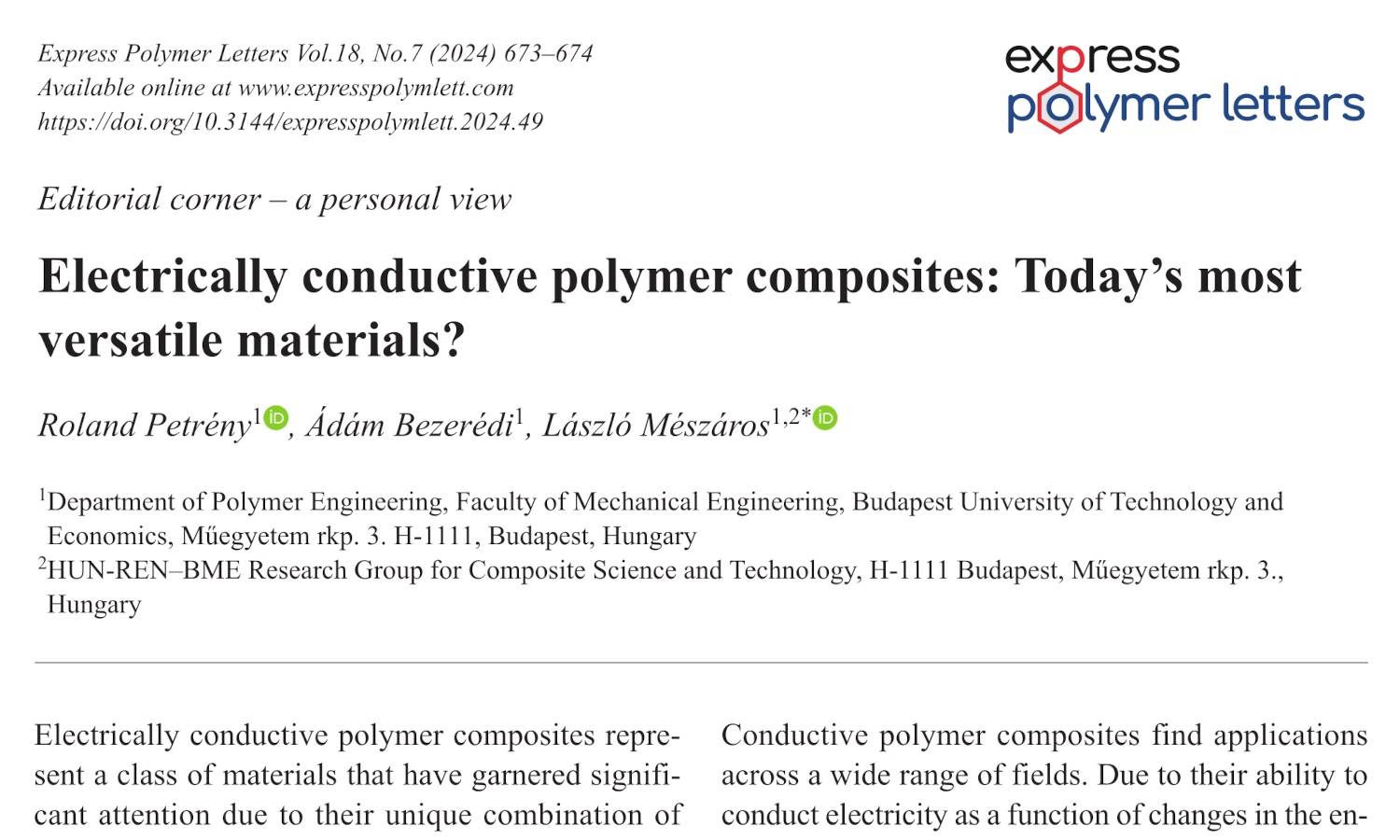
This is an editorial article. It has no abstract.
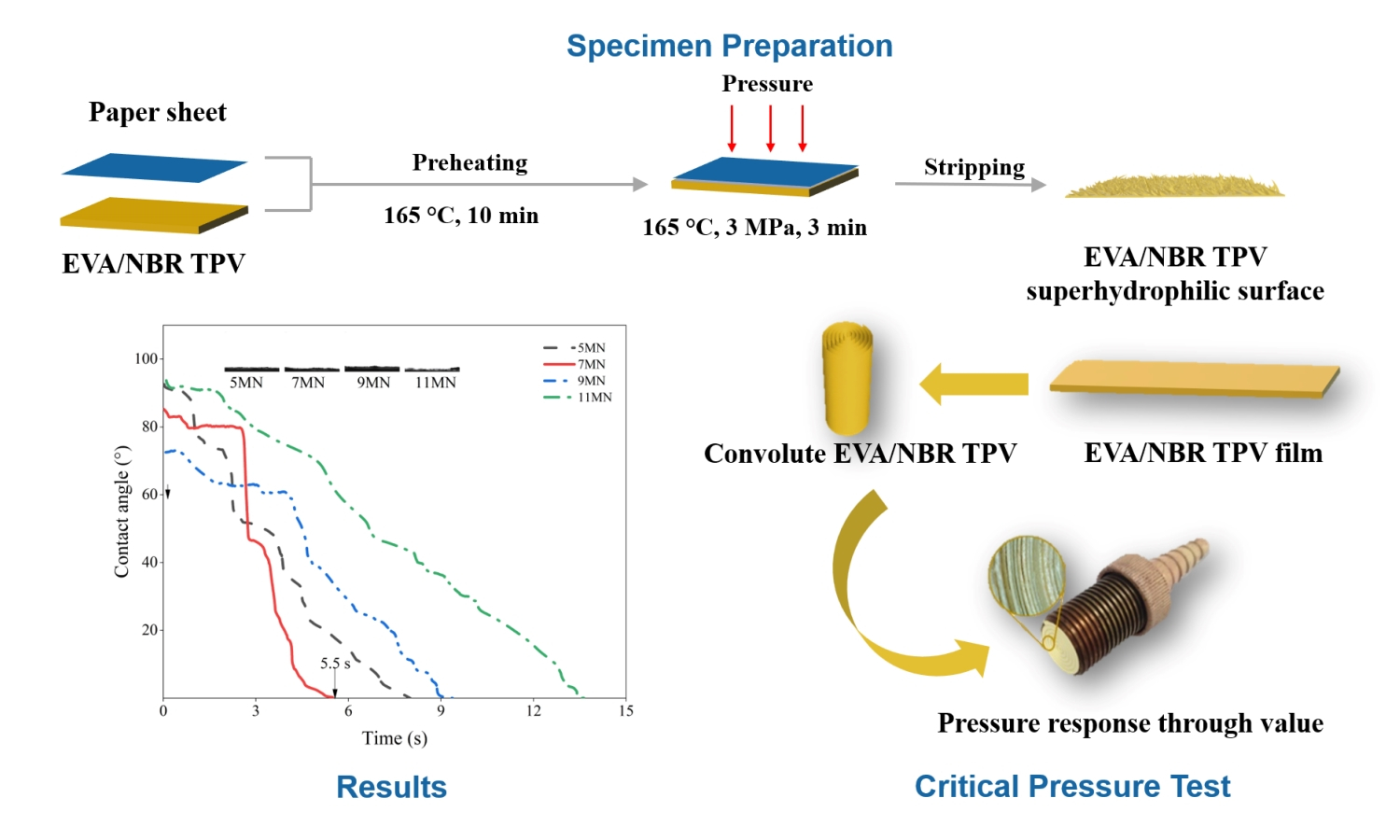
In this research, a straightforward template method was utilized to fabricate a superhydrophilic ethylene-vinyl acetate copolymer (EVA)/nitrile-butadiene rubber (NBR) thermoplastic vulcanizate (TPV) surface where the paper sheet was used as template. Organic modified montmorillonite (OMMT) powder was introduced in order to improve the superhydrophilic response rate of the TPV surface. Investigations were conducted to research the durability and the self-cleaning behavior of the TPV surface, as well as to explore its potential application in the separation of oil-water and oil-oil mixtures. Experimental results demonstrated that the EVA/NBR/OMMT TPV (mass ratio 20/80/7) surface molded with No. 1000 paper sheet exhibited the excellent superhydrophilic property, which could achieve a contact angle of 0.0° within 5.5 s and had a surface energy of 35.6 mN·m–1. The superhydrophilic surface displayed the remarkable durability and the evident self-cleaning behavior; moreover, it could exhibit the significant difference in the critical pressure data for various liquids, suggesting the promising application in the field of oil-water and oil-oil separation.

This study focuses on producing polyurethane dispersion (PUD)/carboxylated nitrile butadiene rubber (XNBR) blends with different types of crosslinkers without both accelerators and sulphur. Two types of crosslinkers: epoxide crosslinker and organo-modified siloxane, are introduced in the PUD/XNBR (blending ratio of 80:20). The zeta potential and particle size of the PUD/XNBR blends were determined using a dynamic light-scattering nanoparticle analyser. The chemical interaction and surface roughness of the PUD/XNBR blends were evaluated using Fourier transform infrared spectroscopy (FTIR) and atomic force microscopy (AFM). The zeta potential and particle size of the PUD were influenced by XNBR blending and the types of crosslinkers. FTIR observations indicate that the XNBR and the crosslinkers facilitated intermolecular hydrogen bonding and different extents of ordered hydrogen bonding. A higher degree of ordered hydrogen bonding can be associated with a higher surface roughness of the PUD/XNBR blends. Nevertheless, the hybrid crosslinkers can be used to achieve reasonable surface roughness for the easier donning of latex gloves. The research findings can be applied to design glove products with desirable surface roughness and intermolecular bonding.

In order to improve the impact toughness of polyamide 1012 (PA1012) by reducing the amount of hydrogen bonding resulting from PA1012 itself, 3-pentadecylphenol (PDP) was considered to be added into PA1012 using melting extrusion. The hydrogen bonding interaction between PA1012 and PDP was characterized by Fourier transform infrared spectroscopy (FTIR) and nuclear magnetic resonance (NMR). The effects of PDP on the crystallization, melting process, and mechanical behavior of PA1012 were tested in detail. The results show that the PDP can reduce the temperature of PA1012 crystallization and melting but it can significantly improve elongation at break and impact toughness. The notched impact strength of the PA1012/PDP composites containing 20 wt% PDP reached to 70.6 kJ·m–2, which is about seven times that of the neat PA1012. The effects of PDP on PA1012 properties is ascribed to hydrogen bonding interaction between hydrogen bonding between phenol hydroxyl groups and amino groups on PA1012 chains. The deduction was also verified by adding acetylated 3-pentadecylphenol (APDP) to modify PA1012. It is believed the research will open up new prospects for the wide application of PA1012 toughening.
Processing effects on crystal morphology and application performance of blown films from propylene-ethylene random copolymers
Markus Zach, Davide Tranchida, Enrico Carmeli, Jingbo Wang, Markus Gahleitner, Bernhard Hofko, Elena Pomakhina, Minna Aarnio-Winterhof
Vol. 18., No.7., Pages 715-727, 2024
DOI: 10.3144/expresspolymlett.2024.53
Vol. 18., No.7., Pages 715-727, 2024
DOI: 10.3144/expresspolymlett.2024.53
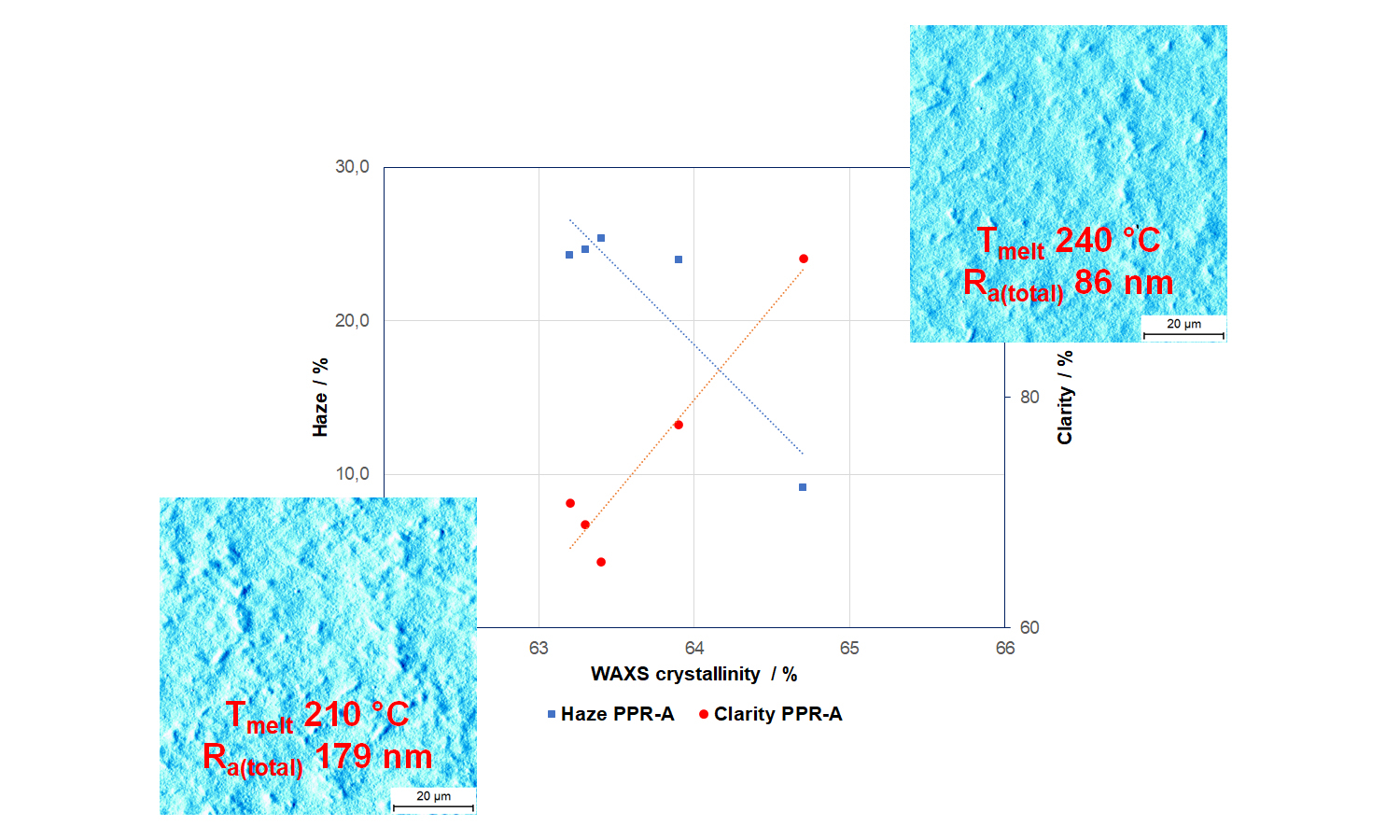
Blown films from ethylene-propylene random copolymers (C2C3-RACOs) are used in many packaging applications today, constituting a major fraction of both mono- and multilayer packaging film constructions. Combining high processing speed and output with good mechanical and optical performance, mostly high toughness and low haze, requires understanding the structure-property-processing relations. To improve said understanding for C2C3-RACO blown films, two commercial grades with a nearly identical C2 content of ~4.4 wt% and identical melt flow rate (MFR) but different nucleation were selected. These were tested in a processing study, varying melt temperature, blow-up ratio (BUR) and neck length. The film structure was analysed by wide angle X-ray scattering (WAXS) and atomic force microscopy (AFM), and the performance by standard mechanical and optical tests. Variation of film crystallinity was found to be in the range of 62 to 65%, much smaller than in earlier cast film studies on comparable polymers. The tensile modulus is the only performance parameter for which a general positive correlation to crystallinity can be found, blown films being about 50% stiffer than the softest cast films of a comparable polymer. Ductility and toughness are enhanced by higher orientation, resulting from higher BUR and/or higher neck length. For transparency and haze, low surface roughness is decisive at comparable crystallinity, which can be achieved by increasing melt temperature.
Deterioration behavior of aged magnetorheological elastomer under harsh marine environment
Nursyafiqah Zaini, Saiful Amri Mazlan, Siti Aishah Abdul Aziz, Mohd Aidy Faizal Johari, Ubaidillah Ubaidillah, Nur Azmah Nordin, Muntaz Hana Ahmad Khairi, Megat Ahmad Kamal Megat Hanafiah
Vol. 18., No.7., Pages 728-741, 2024
DOI: 10.3144/expresspolymlett.2024.54
Vol. 18., No.7., Pages 728-741, 2024
DOI: 10.3144/expresspolymlett.2024.54
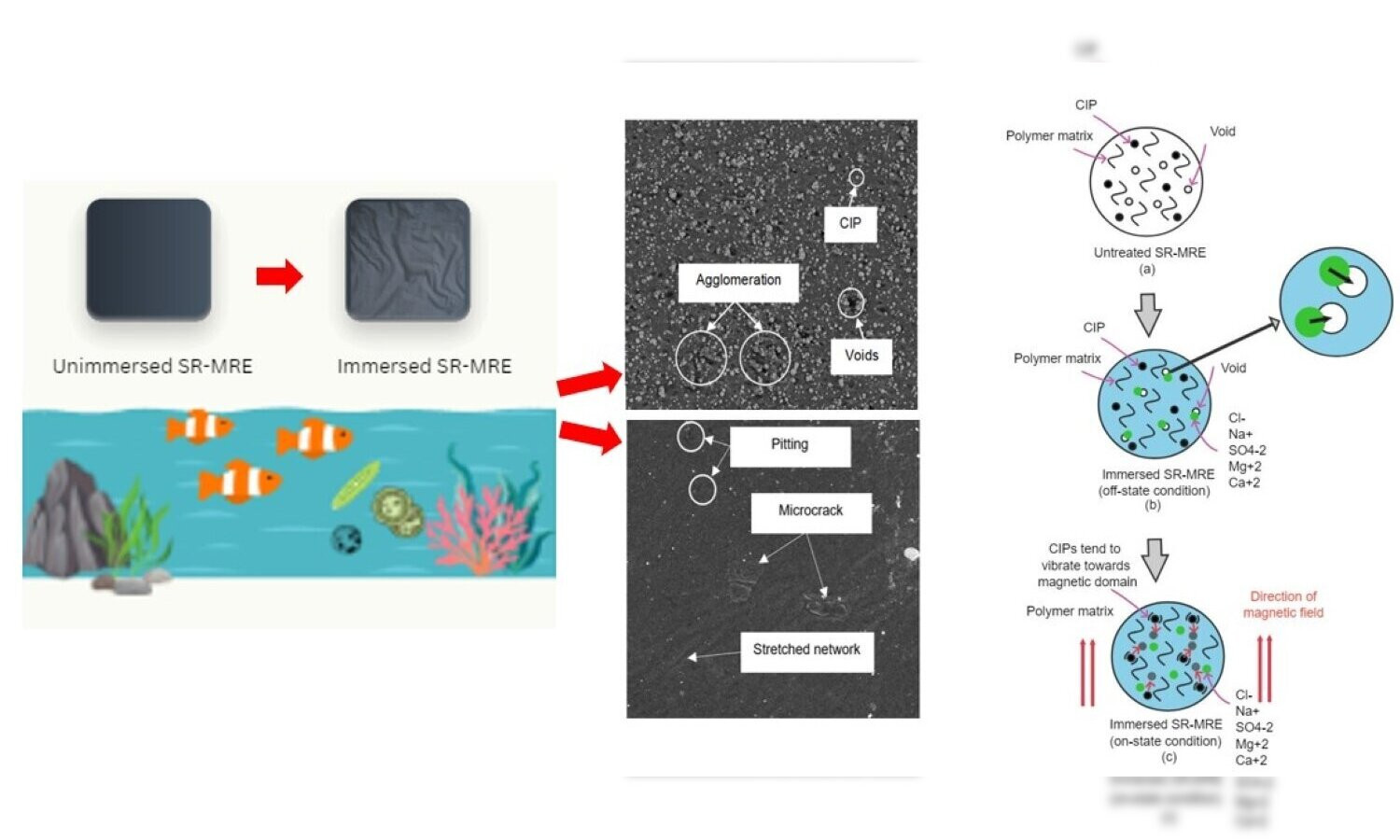
Silicone rubber magnetorheological elastomers (SR-MREs) are increasingly recognized for their resilience in marine conditions, offering prolonged service life and durability. This study evaluates the one-month durability of silicone rubber magnetorheological elastomers (SR-MREs) under seawater conditions. Results revealed a 6% reduction in hardness and an 8% decrease in Young’s modulus compared to unimmersed samples. Morphological and attenuated total reflectance-Fourier transform infrared spectroscopy (ATR-FTIR) analyses supported these findings, revealing surface defects and chemical bonding changes. The immersed SR-MRE displayed a notable 250% increase in elongation at break, highlighting enhanced elasticity. Rheological properties revealed complex mechanical behavior, with an initial increase in storage modulus from 0.25 to 0.38 MPa in the presence of a magnetic field, followed by a gradual decrease to 0.15 MPa at 0 A and 0.52 Mpa at 5 A with strain. Additionally, this study proposes an illustrative mechanism to elucidate the relationship between seawater elements and SR-MRE behavior, enhancing our understanding of its mechanical properties and degradation in marine environments, thus highlighting SR-MRE’s potential as a durable material compared to traditional rubber composites.
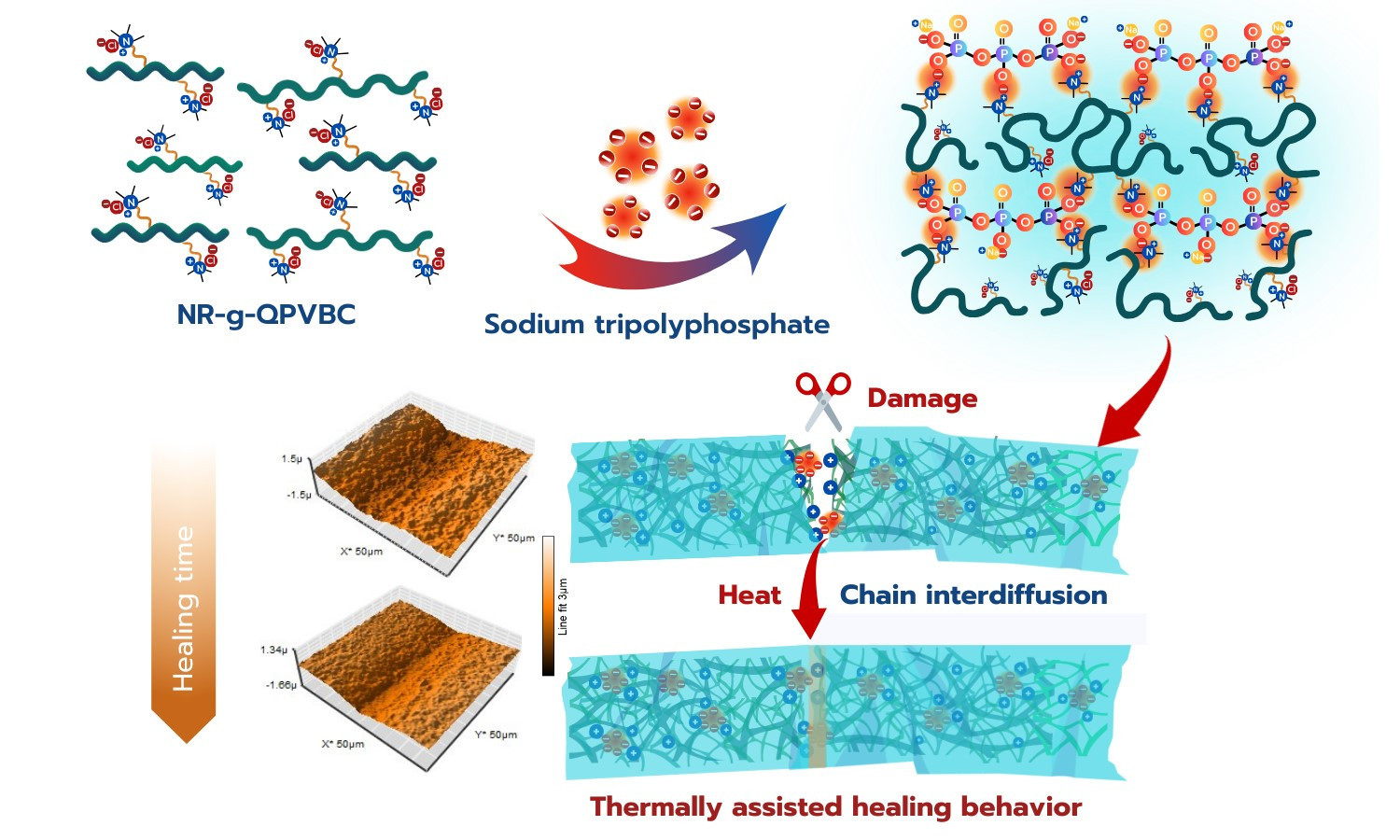
This work reported a practical approach to turning conventional natural rubber (NR) into a thermally healable rubber. 4-vinylbenzyl chloride was first polymerized in the NR latex to yield graft copolymers of NR and poly(vinylbenzyl chloride), NR-g-PVBC. The cutting and rejoining process was used to study the healing ability of latex film. The healing behavior was observed after the reassembled film was heated at 100 °C for 1 h and then allowed to heal continuously at room temperature (RT). The healed film displayed a 58.44% regain of the tensile strength (4.57 MPa) after being allowed to recover at RT for 72 h. Additionally, the chloromethyl moieties in the NR-g-PVBC could be converted into quaternary ammonium (QA) groups by reaction with trimethylamine, producing the quaternized NR-g-PVBC (NR-g-QPVBC). Ionic crosslinking of the NR-g-QPVBC film was achieved by incorporating sodium tripolyphosphate (STPP). The latex film had a tensile strength of 15.32 MPa and could withstand a strain of 868% when ionically cured with 2 phr of STPP. After the healing process, the cured film showed a healing efficiency of 49.67% in tensile strength (7.61 MPa). Furthermore, a suturing test was performed to investigate the feasibility of developing a suture training pad from the corresponding cured film. The film’s ability to heal with heat assistance was its significant practical advantage, enhancing its realism and mimicking the healing process in human skin.
Elucidating the synergistic interactions of macroalgae and cellulose nanofibers on the 3D structure of composite bioaerogel properties
Rayan Y. Mushtaq, Azfaralariff Ahmad, Abdul Khalil H.P.S., Rana Baker Bakhaidar, Waleed Y. Rizg, Shazlina Abd Hamid, Abdulmohsin J. Alamoudi, Che Ku Abdullah, Tata Alfatah
Vol. 18., No.7., Pages 760-777, 2024
DOI: 10.3144/expresspolymlett.2024.56
Vol. 18., No.7., Pages 760-777, 2024
DOI: 10.3144/expresspolymlett.2024.56

Seaweed
from macroalgae and cellulose from nonwood materials have gained attention in
various fields. This study explores how seaweed and cellulose nanofibers (CNF)
interact to form 3D networks in composite bioaerogels. The ratio of CNF and
seaweed was varied to see how it affects the aerogel’s inside and its
properties. The observations show that the biocomposite aerogel is more rigid
and shrinks less than using a single biopolymer. The CNF aerogel has a fine,
thin network structure, and the seaweed aerogel has a thin sheet structure. The
biocomposite aerogel combines both a fine network and a thin sheet structure.
The composite aerogel’s mechanical properties are significantly influenced by
seaweed composition. The introduction of CNF increases elasticity, while
seaweed enhances firmness. Generated computer modelling revealed that the
abundant hydroxyl groups in CNF facilitated the formation of intermolecular
bonds with seaweed. The bonding led to increased adhesion and entanglement
between biopolymers, consequently enhancing elasticity and establishing a
stable intermolecular interaction. The 3D X-ray imaging model shows that the
skeletal framework primarily consists of seaweed biopolymer, with CNF serving
to reinforce this structure thus enhancing the mechanical properties and
robustness of the composite bioaerogels.


